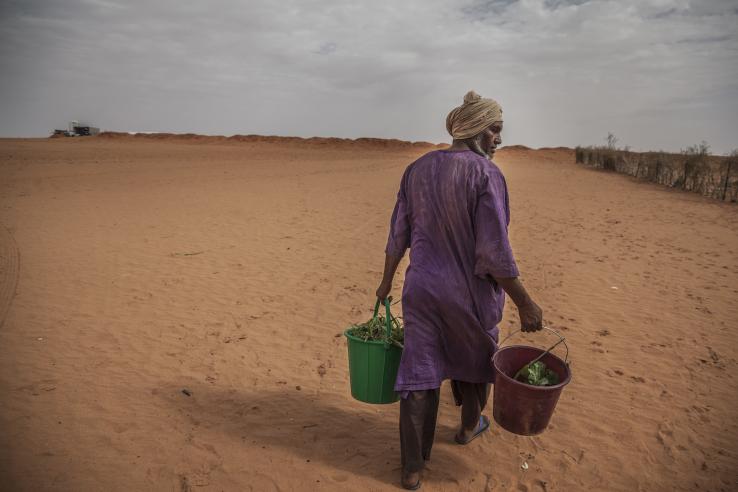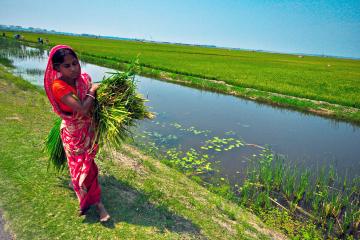
The Evidence Effect: Evidence for action in conflict and crisis

The number of people in urgent need of humanitarian assistance has nearly doubled over the past five years, from almost 170 million in 2020 to more than 300 million today. A combination of factors—including the onset of new and prolonged conflicts and the growing severity of weather-related disasters—have fueled crises that are not only more frequent, but also more complex.
The people caught in these crises are among those hardest hit by cuts to foreign aid. Humanitarian funding is at historic lows, and cuts continue. Just last week, the US House of Representatives approved US$7.9 billion in cuts to foreign aid funding. As a result, many essential services are being scaled back or suspended altogether, leading to preventable deaths and putting millions more lives at risk. Restoring as much humanitarian funding as possible is imperative.
The reality of funding cuts has forced the humanitarian sector to rapidly “reset” to prioritize life-saving activities and find ways to make the most of limited resources. Encouragingly, evidence is emerging to help pinpoint promising solutions and guide investments that can save lives, protect the most vulnerable, and use humanitarian resources most effectively.
Generating evidence even in the hardest places
We already know some things just work. Rapidly mobilizing resources in the wake of crises is critical for ensuring individuals’ most basic human needs are met—including providing timely access to shelter, food, safe drinking water, and healthcare—all of which can prevent emergencies from spiraling into long-term catastrophes.
Still, there’s a lot we don’t know about how to best target and deliver humanitarian aid in rapidly evolving, high-stakes environments in ways that minimize risks and protect civilians from harm. The realities of these settings pose challenges to conducting research safely and ethically. With careful planning and research design, it is possible to conduct impact evaluations of humanitarian assistance that reveal valuable insights even in the most complex environments.
We’ve seen this is possible through a number of our research initiatives. J-PAL’s initiatives on governance and crime and violence have generated impactful insights on effective strategies for building state capacity in fragile settings, responding to and deterring crime and violence, and supporting communities recovering from conflict and disasters. New initiatives are building on this momentum to explore new topics in displacement and humanitarian protection.
And we are not alone in these efforts. A growing number of humanitarian and peacebuilding organizations—including the International Rescue Committee, Mercy Corps, Save the Children, World Food Programme, and others—are investing in randomized evaluations to better understand the impact of their work. Together, these efforts are contributing to a growing global knowledge base that can help shape more effective, evidence-informed humanitarian responses.
What is the evidence telling us?
The power of cash
Getting cash to people quickly, sometimes even before disasters strike, helps families meet basic needs. Humanitarian organizations have long studied how cash and voucher assistance helps households navigate crises, consistently finding it enables families to meet basic needs and improve food security. These findings echo broader research showing that both conditional and unconditional cash transfers can lead to meaningful improvements in well-being, income, and food security for low-income households.
Beyond the lesson that ‘cash works’, how it is delivered also matters. In the Democratic Republic of Congo (DRC), both cash and vouchers increased food security and asset ownership, but cash gave households greater flexibility and was more cost-effective. New research is exploring how best to target aid. Early results from a second study in the DRC showed that machine learning and less costly community-based approaches had similar impacts on community acceptance and satisfaction.
Delivering cash to women using digital tools is also proving effective across many settings. In Niger, mobile cash transfers to women were not only more cost-effective than physical cash distribution, but also led to more diverse diets and their children eating more. In Afghanistan, digital payments to female-headed households improved food security and mental wellbeing, with no signs of funds being diverted to unintended groups. Delivering each dollar cost just 6.7 cents—less than half of the World Food Programme’s global average.
Cash is also a powerful tool in responding to increasingly frequent extreme weather events. Rather than reacting after a crisis, offering support in advance, also known as anticipatory action, when weather forecasts suggest an impending climate shock can help families cope. Providing cash transfers ahead of climate shocks in Nepal and Niger improved food security and psychological well-being more than traditional humanitarian aid delivered following the climate shock. Additional research is exploring integrated strategies—such as livelihood interventions, lean season support, and more often delivered in parallel to cash—for boosting community resilience to shocks. Through the Jameel Observatory for Food Security Early Action, partner organizations are also working to improve systems to better identify early warning signs of weather shocks.
Protecting vulnerable people in conflict zones
Cash assistance is a valuable tool in humanitarian response, but it does not address every challenge communities face in crisis. Families still need essential healthcare, education, and, critically, protection from violence, coercion, and abuse.
Addressing these complex issues requires strategies that go beyond cash. J-PAL and Innovations for Poverty Action (IPA)’s Humanitarian Protection Initiative is supporting some of the first randomized evaluations focused on protection outcomes. For example: in the Central African Republic, the Growing Stronger Together program is testing whether supporting caregivers with parenting tools and tailored family support can prevent child recruitment into armed groups and support those returning home. In Burkina Faso, a pilot project is studying whether training and peer support can protect women entrepreneurs—especially those displaced by conflict—against sexual exploitation.
Early findings from a series of studies we are supporting in the DRC has found that a simple empathy-building program tripled the rate that combatants left an active militia. The program uses weekly perspective-taking exercises that present scenarios prompting combatants to envision themselves in the position of other community members, fostering empathy and reducing civilian abuse.
Supporting long-term recovery and inclusion
Conflict leaves lasting scars–on individuals, communities and institutions. We are therefore also studying ways to improve service delivery after conflict, improve well-being for both displaced and host communities, and foster inclusion between people affected by conflict.
In addition to shifting combatant behaviors in the DRC, perspective-taking programs that encourage people to envision spending a day in another person's shoes are also showing promise for building empathy and more inclusive societies. In Turkey, an interactive classroom program reduced peer violence and improved relationships between Syrian refugees and Turkish students. In Colombia and Hungary, virtual perspective-taking programs similarly improved attitudes and reduced prejudice towards migrants and refugees. These efforts contribute to a broader body of work exploring how to rebuild social cohesion following conflict—including through community reconciliation, mixed sports leagues, and more.
Beyond social integration, we are investigating how to best strengthen livelihoods, self-reliance, and economic inclusion of people experiencing displacement. In Bangladesh, for example, offering Rohingya refugees employment for two months improved psychosocial well-being more than providing cash alone—highlighting that work can have more value than just income. Through our Displaced Livelihoods Initiative with IPA, we are answering a range of additional questions—exploring strategies to boost uptake of mental health services, support refugee business development, and connect displaced people to government services.
Continuing to learn and adapt in crisis settings
The examples above illustrate that randomized evaluations are possible in complex, conflict-affected settings—and are already helping inform more effective humanitarian and development responses. Given how many people’s lives are at stake as humanitarian budgets shrink, this is a critical moment to build on what we’ve learned. Strong partnerships between researchers and implementers are key to ensuring insights are grounded in local realities and translated into action.
Still, there is much more to learn. While the evidence base is expanding—particularly around cash assistance models—important gaps remain. Many humanitarian challenges remain unsolved, and traditional tools may not be enough. First and foremost, funding should be preserved for delivering life-saving services. But even in a constrained funding environment, investing in research and innovation should remain a priority. By generating sharper insights into what works, for whom, under what conditions, and at what cost, we can help communities not only weather today’s crises, but also build stronger and more resilient futures.
Related Content

The Evidence Effect: What we’ve learned working with the private sector for inclusive growth

The Evidence Effect: The unique value of aid and philanthropy—four essential roles


